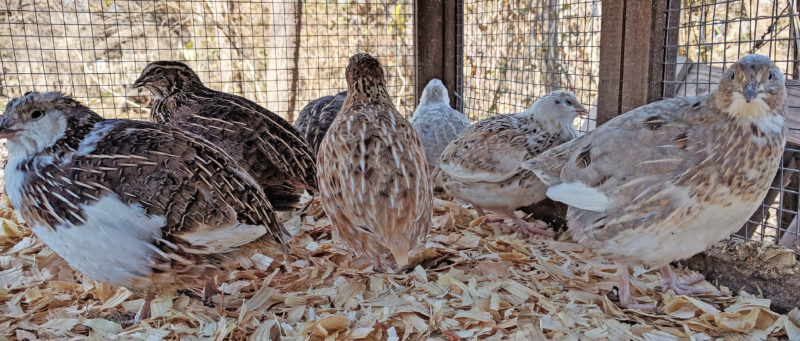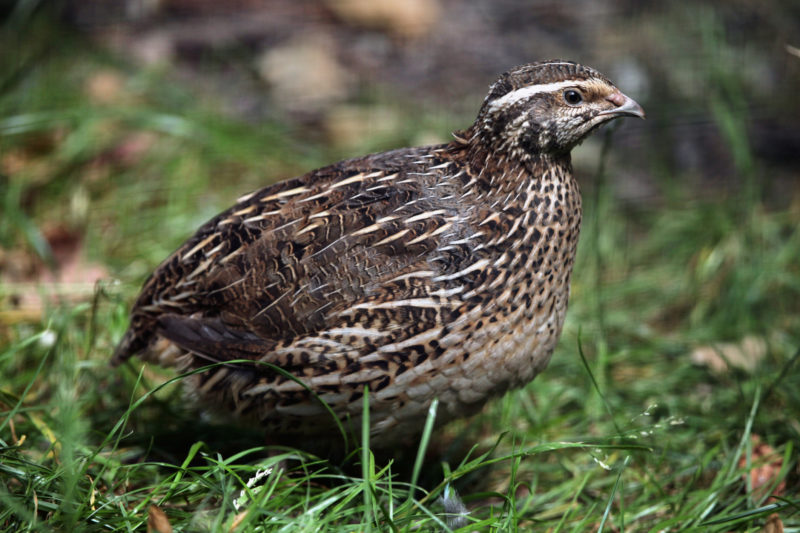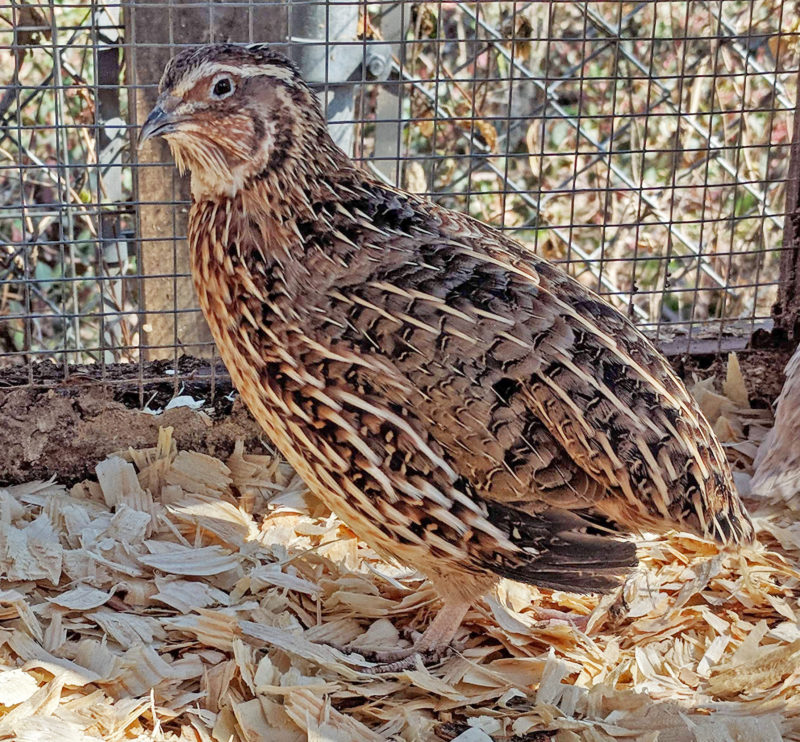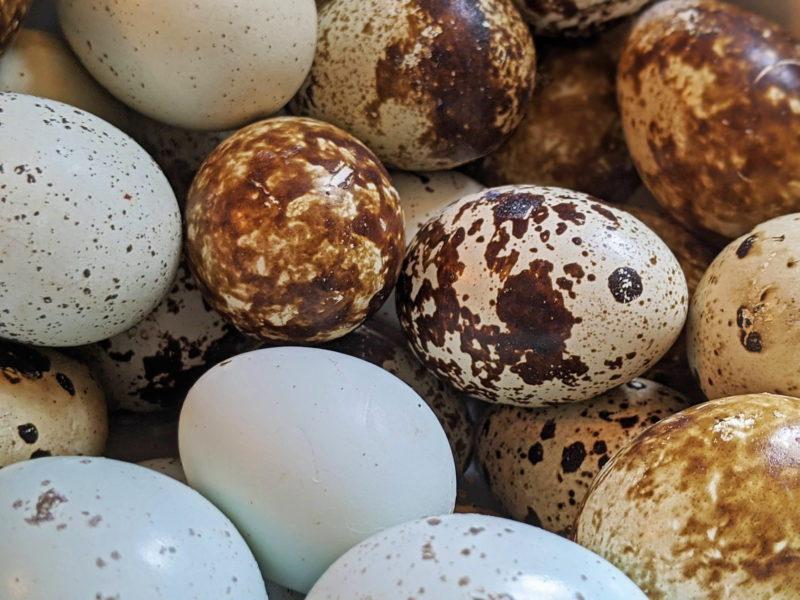Domestic quail and their fascinating history, by Kelly Bohling.
Since I started keeping Japanese quail several years ago, I’ve often wondered just how long people have kept them domestically. Exactly how new, or old, is this line of beautiful little birds, and has it changed much over the years? Are their wild relatives still around? While the exact development of modern-day domesticated Japanese quail is somewhat uncertain, it’s clear that many of the traits we find so endearing about these quail today also enticed ancient civilizations to begin domesticating them.

Variety of modern Japanese quail colors. Photo by Kelly Bohling.
Get to Know Japanese Quail
Japanese quail, or Coturnix japonica, are native to large swaths of Russia, East Asia, and eastern Africa. Wild populations currently exist in these regions in multitudes, as do many of their close relatives in the Coturnix genus. Members of the genus Coturnix are Old World Quail, to be distinguished from New World Quail, genus Odontophoridae. Japanese quail are by nature ground-residing birds. They prefer areas of grassland and foothills, where undergrowth and tall grasses provide ample cover. These birds don’t roost in trees, instead hiding in brush and vegetation for protection and safety. Even domestic Japanese quail show these tendencies and love to hide in hollow logs, in clay pots laid on their sides, or under large pieces of bark. Wild quail subsist on a diet of various grass seeds, native and domesticated grains, and small insects, which are all favorites of the domesticated quail as well. What my quail wouldn’t do for a few cabbage worms or crickets!

Japanese quail (Coturnix japonica). Getty Images.
There are some notable differences between wild and domesticated Japanese quail, however, most arising from selective breeding in captivity. While the males of both populations tend to be smaller than females, wild quail of both sexes aren’t as heavy as their domesticated relatives. The weight of wild adults on average is between 3 and 3-1/2 ounces. The weight of domestic adults can reach up to 10 ounces or more, with some varieties boasting weights of up to 14 ounces. In terms of egg production, wild hens will lay clutches of eggs averaging 5 to 10 eggs per clutch, and the hen will incubate these on her own. Domestic Japanese quail rarely incubate their own eggs, and when it does happen, it’s nearly always when they’re kept in a solid-bottomed coop or on the ground (something resembling their natural, wild habitat). Wild Japanese quail sport a single type of plumage coloration and pattern, unlike domestic quail, which are now available in a wide range of colors. The wild coloration is actually still found among domestics and is better known as the “Pharaoh” color. This coloration carries some characteristic differences between the sexes, and those differences are often used to help sex the birds. However, variations do occur, and it’s not always a completely accurate way to identify sex.

Pharaoh quail. Photo by Kelly Bohling.
Quail Across History
Wild quail make several appearances in written records from ancient cultures, including references from the biblical Old Testament and passages from The Histories by ancient Greek historian Herodotus in 430 BC. Even the ancient Egyptians represented quail in hieroglyphic form; the hieroglyph of a quail stands for the sound of the letter “w.” However, it’s unclear exactly what species of quail were intended in any of these cases, as many species were and still are native to those areas of the world, each species known by a variety of names. Even today, a wide assortment of names exist for the same quail species, which often creates confusion of identity from region to region. Furthermore, closely related species within the Coturnix genus are known to interbreed and create recognized hybrids.
It’s not known whether the peoples who referenced quail in their written and pictorial histories in fact kept them domestically at that point in time. What does seem to be substantiated at this period is the practice of hunting the wild quail populations, who were known to fly low over fields and other crops. The migratory patterns of wild quail took them over Egypt and other regions in droves in the fall, when they migrated over the Mediterranean – something wild quail populations continue to do today. It’s documented that people in this time period would often capture the low-flying birds in plentiful numbers for food, taking advantage of birds who were weak or exhausted from their long journey.
The ancestors of the birds we today identify as Japanese quail were eventually domesticated, though, and it’s widely accepted that this occurred around the 11th and 12th centuries in Japan, and that the birds were perhaps brought there from China. It’s unknown whether the name “Japanese quail” comes from this purported location of first domestication, or because they’re native to this region. Some sources claim that they were initially raised in Japan as singing birds, with Samurai even cultivating their own personal lines of these “singing quail” to participate in singing competitions. The winning quail were then kept in a closed population of birds in an effort to continue selectively breeding winners for generations. Multiple lineages of these singing quail were developed over the centuries in Japan up until World War II, and by that point, several other lines arose for commercial meat and eggs.

Quail eggs. Photo by Kelly Bohling.
Productive Birds
Japanese quail are perhaps best known for their impressive egg production capabilities. Domestic birds reach maturity between four and six weeks of age and can begin laying eggs at six weeks old, which is quite young when compared to other domestic fowl such as chickens. This means a single hen could potentially lay around 300 eggs in her first year, making quail-keeping a consistent and potentially lucrative source of food and product to sell in historical times. Additionally, quail are relatively disease-resistant and quite hardy. Their wild relatives, however, reach maturity a few weeks later and don’t lay as many eggs, so these biological gains point to selective breeding by humans over many generations. Furthermore, domestic quail achieve this productivity with relatively little demand for space and feed, especially when compared with chickens. In fact, the ratio of egg size to body weight is higher for a quail than a chicken. This modest demand on resources alone would’ve been appealing to people in that time period, just as it is today.
In the decades between 1900 and the start of World War II, the domesticated quail industry boomed in Japan, boasting numerous lines of quail bred for their singing, prolific egg laying, and robust meat production. However, by the end of the war, the singing lines had been completely lost, and the few Japanese quail remaining in Japan were from a handful of egg-laying and meat lineages. In the years following the war, these remnants were bred together, perhaps also with imported Japanese quail from domestic populations in nearby countries. The offspring of these birds are considered to be the founders of most of the current domestic populations in Europe and the United States. In the years directly following the end of the war, Japanese quail also began to appear as test subjects for laboratory study, a practice which continues to this day.
The Modern-Day Quail
Japanese quail lines today are developed for egg production, meat production, dual-purpose (eggs and meat), or specific plumage colors. Most Japanese quail are inherently good egg producers, provided they’re fed a high protein diet and adequately cared for. The average quail egg weighs in at 10 grams, or roughly a fifth of the weight of a chicken egg. Developing lines for meat production, on the other hand, requires more selective breeding and thorough record-keeping of the weight of each bird at maturation age in order to produce birds with more meat mass. Some meat developers weigh the quail eggs themselves before incubating and hatching, only selecting eggs that are heavier than average, while trying to avoid double yolks. This practice isn’t universally accepted, and most meat producers will rely more on recorded weights and maturation speed, since egg weight isn’t guaranteed to ultimately produce a larger adult. Most quail destined for meat production are harvested between seven and eight weeks old, so it’s desirable to breed for quail that develop quickly into large adults. Quail harvested much older than that will have tough meat.
Texas A&M quail are a good example of a line developed primarily for meat production. As their name would suggest, this line was developed at Texas A&M University to produce a heavier bird with lighter colored meat, which purportedly improves the taste for many. Promoters also claim the bone-to-meat ratio is better and that they’re easier to butcher and clean. Texas A&M’s were actually the first type of quail I raised, as it was what was locally available at the time. These birds are generally white with the occasional black marking, relatively quiet, and can supposedly grow to weigh 12 to 14 ounces at maturity at 7 to 8 weeks old, which is well more than double the weight of its wild relatives. Many quail hatcheries also market other “jumbo” varieties, which advertise individuals potentially averaging about 12 ounces.
Whatever the reason you may choose to raise Japanese quail, they’re fascinating examples of selective breeding over centuries, and new developments in the species continue. Admiration for the beauty, tenacity, and productivity of these little birds connects us to quail keepers across countless generations and continents.
Kelly Bohling is a native of Lawrence, Kansas. She works as a classical violinist, but in between gigs and lessons, she’s out in the garden or spending time with her animals, including quail and French Angora rabbits. Kelly also spins the Angora fiber from her rabbits into yarn for knitting, which can be found in her Etsy shop, ThreeRabbitYarns. She enjoys finding ways that her animals and garden can benefit each other for a more sustainable urban homestead. You can also follow her on Instagram.













1 Comment
Really a nicely texed message on Japanese quails with enormous informatios